By Naved Masood for TwoCircles.net,
Nawab Hafiz Sir Ahmad Said[[i]]Khan
Zamindars in parts of Northern India[[ii]] enjoyed the right to collect land revenue in their ‘estates’ (Zamindaris). They also had to perform certain ‘managerial functions’ on behalf of the government within their ‘estates’. Most (though not all), were titled ‘Nawab’ or ‘Raja’ depending on their religious affiliations. The common public perception of the Zamindar was one of a petty tyrant to the tiller of the soil who was a lackey of the ‘sarkar’ and an impediment to any improvement in agrarian conditions. This was substantially correct as it conformed to observed facts. There were exceptions to this prototype; among the Zamindars a few displayed extraordinary managerial abilities, and fewer still who were a friend to their ‘ryots’[[iii]]. Rare indeed was the Zamindar who combined in himself the two virtues – Nawab Ahmad Saeed Khan of Chhatari was one such rarity.

Nawab Chhatari
Formative Years
Born in 1888, Ahmad Saeed Khan was the son of Abdul Ali Khan[[iv]] the Zamindar of Chattari then a small estate administratively in Bulandshahr District but more proximate to Aligarh city some twenty miles away. The family was ‘Muslim Rajput’ or ‘Lalkhanis’. Ahmad Saeed started his school education late as he had early religious instructions at home resulting in his being a “Hafiz’ i.e. one who commits the entire Quranic text to memory. He joined ‘English House’, the boarding for the scions of the elite away from but attached to the Muhammedan Anglo Oriental Collegiate School popularly known as ‘Minto Circle’. After passing the matriculate or tenth class in 1906 he had to concentrate on managing the affairs of his Zamindari following the death of his father. So small was his ‘estate’ that initially he was not even recognised as ‘Nawab’ and had to be content with the title “Kunwar”, it was in 1915 that he was recognized as “Nawab” for life – the title was made hereditary four years later in recognition of his proven capabilities which will find mention later.

Nawab Chhatari with Syedna Tahir and Maulana Azad
The settlement report of Bulandshahr District (1915) takes note of the unusual interest taken by the young Zamindar in ‘agricultural improvements’ in his Zamindari. By then a good number of Zamindars were indolent absentees staying in the comfort of cities with the management of the estates being left to local musclemen or resident relatives. The cultivators were often harassed not only for realization of revenue but even for collection of arbitrary levies which sometime extended to the absurd hathiana and motorana being respectively cost of maintaining elephants and motor cars! Anyway, a feature of Nawab Sahib’s Zamindari management was his constant endeavour to develop infrastructure in his village, improvements in cattle breeds and seed quality so that the income from the estate improved. By 1920 he had managed to add many more villages to Chhatari by buying their Zamindari rights. What is more, he managed to establish new villages by bringing fallow tracts under cultivation. Indeed in later years he was to lament (in his two volumes autobiography yade ayyam) that if he had the foresight he would be establishing industries rather than acquiring more villages. The fact remains that in a few decades before abolition of the system, he was the last Zamindar in UP to have considerably added to his estate.
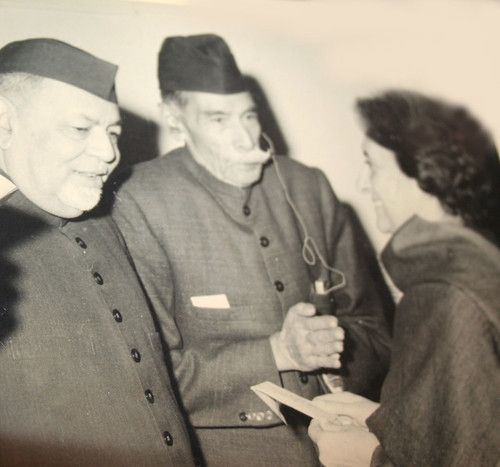
Nawab Chhatari with Indira Gandhi
Public Life
The introduction of elected District Boards in the wake of the Government of India Act 1919 provided an opportunity to local elites to work for area development of their District as also to try their hand at ‘party politics’. While much development was witnessed in the southern and western parts of the country, in UP there was little progress and much politics in the Boards. One of the very few exceptions was Bulandshahr where the young Ahmad Saeed was first elected Chairman of the Board. The experience he gained in improvement of his own estate was put to very good use in the public cause and his Board stole a march over all others in the matter of opening schools, extending irrigation network, opening of dispensaries and above all starting the innovative practice of starting arrangements for marketing of agricultural produce – Bulandshahr soon became a ‘show case’ with Presidents and other office bearers of other District Boards making a beeline for the place to see for themselves how the hitherto unachieved was achieved.
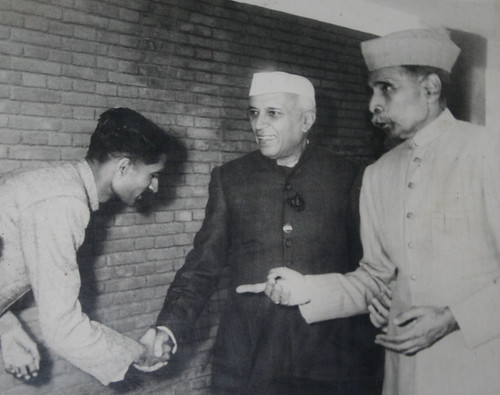
Nawab Chhatari with Nehru
His achievements did not go unnoticed and the Zamindars of the District elected him to be the member of the UP Legislative Council in 1920 where he played a pioneering role in initiating policies to develop agro-industries and institutional credit for the agricultural sector. As Minister Industries he was the founding father of establishing sugar industry and modern flour mills in the province. In 1925 he was appointed Home Member[[v]] a position which he held till 1933. As Home Member he was responsible for introducing a system of competitive test for recruitment of ‘upper subordinates’ (personnel above the rank of Head Constable) replace the earlier system of ‘recommendations’. He also took the revolutionary step of throwing open recruitment of certain ‘excluded castes’ – chiefly ‘ahirs’ and kurmis – at the upper subordinate level. In politics he was the leader of Zamindar party in the provincial legislature. Being a cross-communal alliance this party is believed to have acted as a cushion in absorbing communal tensions in the period 1925 to 1935. With a proven track record in consensus building he was an invitee to the first and second round table conferences held in London to find a solution to the political problems of India and to frame a constitutional framework for the country to accommodate the emerging political realities.
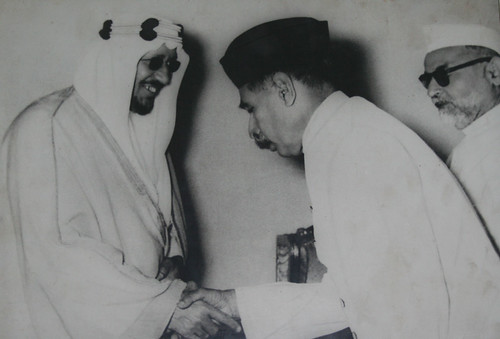
Nawab Chhatari with King Saud and Dr Zakir Hussain
His public services and administrative competence were recognised when he was appointed to officiate as Governor of UP for a year in 1933 – this was the first time ever that an Indian was appointed to the position in any province. He was knighted in 1928 and there are indications that in 1933 there was a move to make him a ‘Lord temporal’.
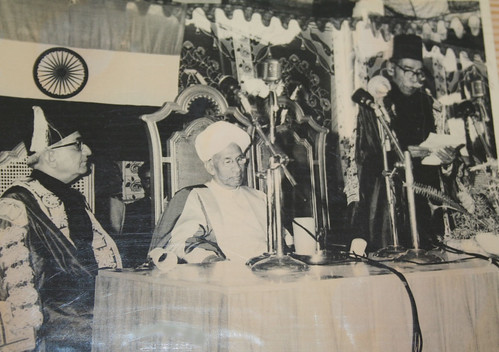
Nawab Chhatari with Dr Radhakrishnan and MC Chagla
Following the enactment of the Government of India Act 1935 which introduced a quasi federal polity, he withdrew from active politics but his counsel remained available in Government Committees. He was invited to be the Prime Minister of Hyderabad State in 1941, a position which he held till 1943 and to which he was reappointed in 1947 at a time of great turmoil. He made sincere efforts to facilitate peaceful merger of Hyderabad with the newly emerged Indian Union but was made to quit by the hotheads led by Qasim Razvi of the Majlis-i-Ittehadul Muslimeen with tragic consequences wrought by Police Action of September 1948.
Aligarh Affairs
He remained involved with the affairs of the MAO College and the University throughout his life from 1911 when he was first elected a Trustee of the College. He was the founder member of the Court of the University and remained associated with that body either as member or late Pro Chancellor and later still as Chancellor. His association with the Government of UP stood the University in good stead as he was instrumental in providing finances for establishment of the Ahmedi School for the Blind and in sanctioning grants for the Girls School and Intermediate College run by Shaikh Mohammed Abdullah till the institutions became part of the University in 1941.
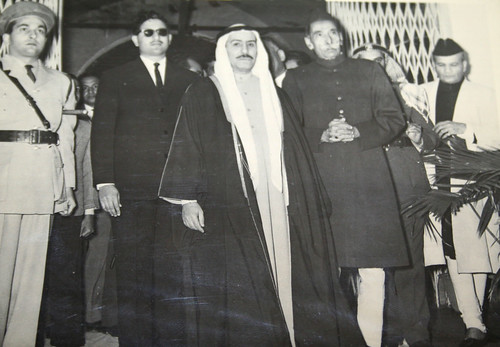
Nawab Chhatari with Amir-e-Kuwait Jabir Al Sabah
In later years though his association with the University was in very formal and titular positions as Pro Chancellor and Chancellor, he was a symbol of continuity and a link of the past with a fast changing scenario – such linkages have their own importance in maintaining continuity and stability in institutions.
The Extraordinary Human Being
A man of innate charm and pleasant disposition, to all who had the good fortune of coming in contact with him, his humility and affection was palpable. In a speech in Aligarh Mrs. Vijaya Lakshmi Pandit recounted that when she was incarcerated in Naini Central Jail for her part in the Civil Disobedience Movement in 1933 Nawab Sahib came to inspect the prison as Governor and burst into tears seeing the daughter of Motilal Nehru languishing behind bars.
In his autobiography he refers to the death of his wife who left behind young children and mentions that during the course of the day he would play joyfully with the children and at night tiptoe to their room and shed tears at their loss. As long as age and health permitted, he personally led Taraweeh prayers in the mosque attached to his residence Rahat Manzil in Aligarh.

Nawab Chhatari, Fakhruddin Ali Ahmad and others in the AMU Riding Club
It was not as if he was just a bundle of touching emotions, unlike the run of the mill landlord he had imbibed much wisdom in his eventful career. In 1977 he invited those who had made it to the IAS and allied services over for dinner at his place; dining over, he gave us three pieces of advice which are worth repeating in full. First do not praise or run down anyone in superlatives – you may have to change your opinion. Second control your anger – it is infectious. Third learn the language of the people among whom you find yourselves – else you will be at the mercy of vested interests. It is a moot point how much of that sage advice was put to practice by us but thirty-four years down the road this writer testifies to their innate perspicuity.
—————————————-
[i] That his how the name was spelt in Government records.
[ii] In Punjab the term Zamindar simply connoted a peasant.
[iii] This word is an anglicized corruption of the word “reyaya” or subject of a ruler. In its corrupted form, however, the word means peasants paying land revenue.
[iv] It is a coincidence no doubt but an extraordinary coincidence that two of the most enterprising Muslims of the last century, Khwaja Abdul Hamied and the Nawab of Chhatari were born within a radius of twenty miles and their fathers bore the same name – Abdul Ali!
[v] Under the Government of India Act 1919 certain subjects were ‘transferred’ to the provinces and included agriculture, education and industries etc – these subjects were looked after by Ministers appointed among elected members of the Legislative Council; other subjects like Home and Finance were ‘reserved’ and directly administered by the Governor with the help of ‘Members’ who were de facto Ministers subject to the difference that their accountability was to the Governor and not the Council.
[Photos Courtesy: aligarhmovement]
